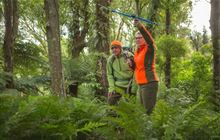Vegetation inventory and monitoring
Introduction
This module describes methods to inventory and monitor vegetation communities and forest canopies.How to use this module
- Read project planning guides.
- Read the methods to inventory and monitor vegetation.
- Consult the introduction and the comparative tables and decision trees to help you select the method(s) most appropriate for your study.
- Be aware of the minimum data collection standards for methods.
- Check if any training is available for this method.
Introduction
How to decide the best method for vegetation monitoring (PDF, 1,141K)
Read this introduction and consult the comparative tables and decision trees to help you decide the method(s) best suited for your project objectives.
Methods
Aerial canopy survey (PDF, 1,289K)
This method can monitoring the dieback and overall condition of the forest canopy.
Foliar browse index (PDF, 471K)
This method monitors changes to the condition of the forest canopy in response to possum browse pressure.
Permanent 20 x 20 m forest plots (PDF, 1,228K)
This method is more suitable to monitor changes to the composition and structure of woody vegetation.
RECCE plots (PDF, 1,140K)
This method can inventory and monitor changes the composition and structure of woody and non-woody plant communities.
Scott height frequency transects (PDF, 1,185K)
This method can inventory and monitor changes to the structure and diversity of grasslands and other non-woody plant communities.
Wraight plots (PDF, 1,351K)
This method can inventory and monitor changes to the structure and diversity of grasslands and other non-woody plant communities.
Related link
On the National Vegetation Survey Databank website you can access:
- Field manuals for foliar browse index
- 20 x 20 m forest plots
- RECCE forest plots
- Scott height frequency transects
- Wraight plots.

